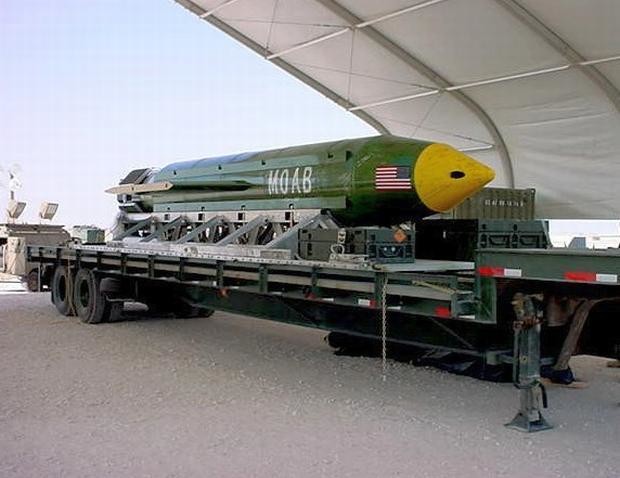US drops ‘Mother Of All Bombs’ in Afghanistan

This photo provided by Eglin Air Force Base shows the GBU-43/B Massive Ordnance Air Blast bomb. The Pentagon says US forces in Afghanistan dropped the military’s largest non-nuclear bomb on an Islamic State target in Afghanistan. A Pentagon spokesman said it was the first-ever combat use of the bomb, known as the GBU-43, which he said contains 11 tons of explosives. The Air Force calls it the Massive Ordnance Air Blast bomb. Based on the acronym, it has been nicknamed the “Mother Of All Bombs.” (Photo from the Eglin Air Force Base via AP)
WASHINGTON—The US military on Thursday dropped the largest non-nuclear bomb ever deployed in combat, targeting an Islamic State complex in Afghanistan, the Pentagon said.
The GBU-43/B Massive Ordnance Air Blast bomb — better known by its nickname, the “Mother Of All Bombs” — hit a tunnel complex at 7:32 pm (1502 GMT) in Achin district in Nangarhar province, US Forces Afghanistan said in a statement.
US President Donald Trump called the mission “very, very successful.”
The huge bomb, delivered via an MC-130 transport plane, has a blast yield equivalent to 11 tons of TNT, and the weapon was originally designed as much to intimidate foes as to clear broad areas.
“The GBU-43/B is the largest non-nuclear bomb ever deployed in combat,” Air Force spokesman Colonel Pat Ryder said.
Article continues after this advertisementAchin District Governor Esmail Shinwari said the bomb landed in the Momand Dara area.
Article continues after this advertisement“The explosion was the biggest I have ever seen. Towering flames engulfed the area,” Shinwari told Agence France-Presse (AFP).
“We don’t know anything about the casualties so far, but since it is a Daesh (IS) stronghold we think a lot of Daesh fighters may have been killed.”
US Navy Captain Bill Salvin, spokesman for US Forces Afghanistan, said in an email to AFP that a bomb damage assessment was being carried out.
As to the possibility of civilian casualties from such a huge weapon, Salvin said: “Friendly forces scouted the area and noted the lack of civilian presence. The target was chosen to ensure the maximum effect against (IS) while preventing civilian casualties.”
General John Nicholson, who heads US Forces Afghanistan, described the weapon as the “right munition” to reduce IS obstacles and maintain the momentum against jihadists in the region.
The strike hit a system of tunnels and caves that IS fighters had used to “move around freely, making it easier for them to target US military advisers and Afghan forces” nearby, White House spokesman Sean Spicer said.
“We must deny them operational space, which we did,” Spicer added.
The Afghan government was aware of the US plan to bomb the IS tunnel complex, presidential spokesman Shah Hussain Murtazawi suggested.
“Heavy casualties have been inflicted on the enemy,” Murtazawi said on Facebook, ruling out the possibility of civilian casualties.
IS in Afghanistan
The US military on Tuesday said an American special forces soldier had been killed while conducting operations against IS in Nangarhar, although it was not clear if Thursday’s strike was connected.
Nangarhar, which borders Pakistan, is a hotbed of IS militancy. US forces have conducted a number of air strikes on jihadist bases in the area since August last year.
IS, notorious for its reign of terror in Syria and Iraq, has been making inroads into Afghanistan in recent years. It has attracted disaffected members of the Pakistani and Afghan Taliban as well as Uzbek Islamists.
READ: Islamic State gaining ground in Afghanistan—UN
But the group has been steadily losing territory in the face of heavy pressure both from US air strikes and a ground offensive led by Afghan forces.
READ: Report: Islamic State group’s ‘business model’ near collapse
The Islamic State group’s strength in Afghanistan has fallen to 600 to 800 fighters from 3,000 in early 2016, NATO has said, adding that it killed the top 12 IS commanders in the country last year.
The MOAB was rapidly developed in 2002-2003 around the time of the US-led invasion of Iraq.
According to the Air Force, the last time the MOAB was tested in 2003, a huge mushroom cloud could be seen from 20 miles (32 kilometers) away.
Despite its massive power, the MOAB still pales in comparison to a nuclear weapon.
Even the smallest of the US military’s atomic arsenal, the B-61 at its minimum configuration, has an explosive yield roughly 30 times that of the MOAB.
(This story was first published at 2:10 a.m. of April 14, 2017.)